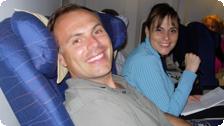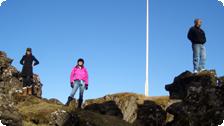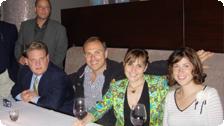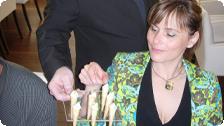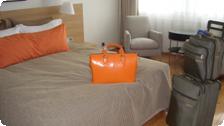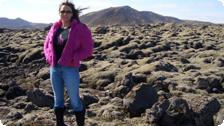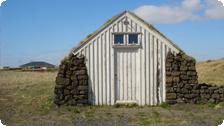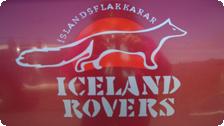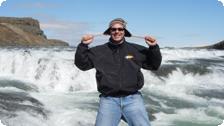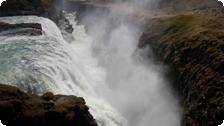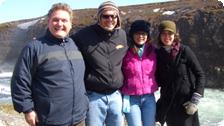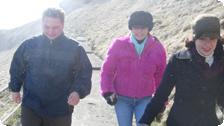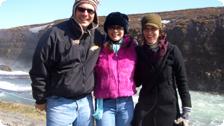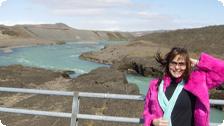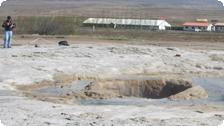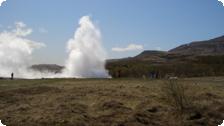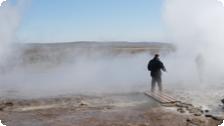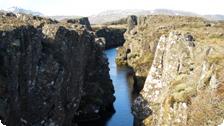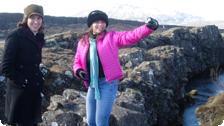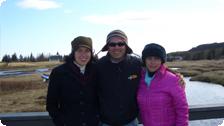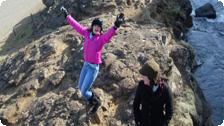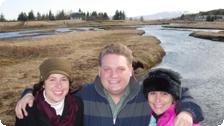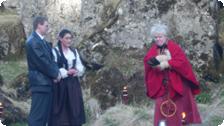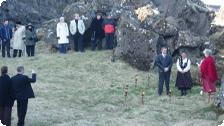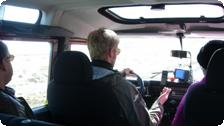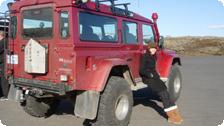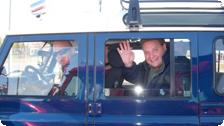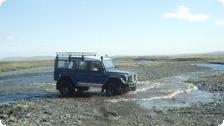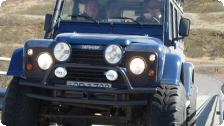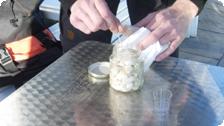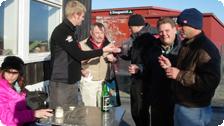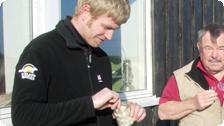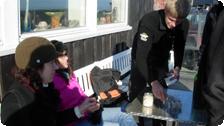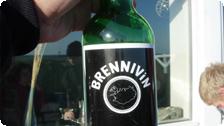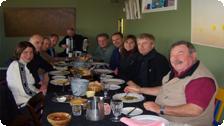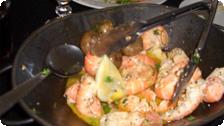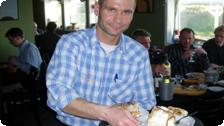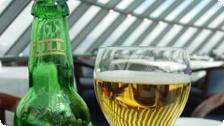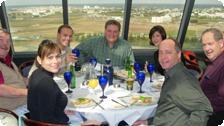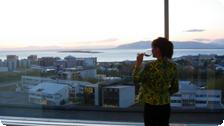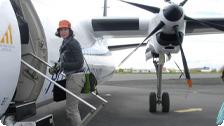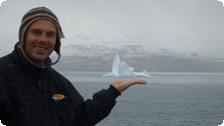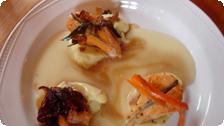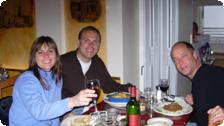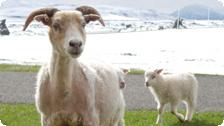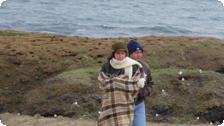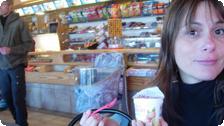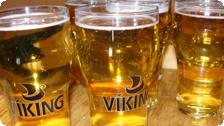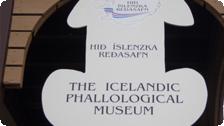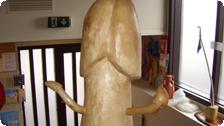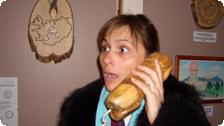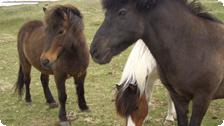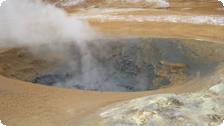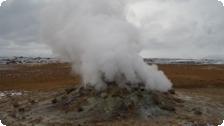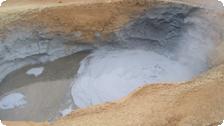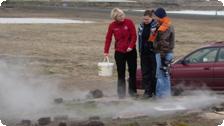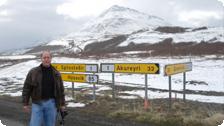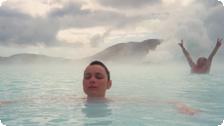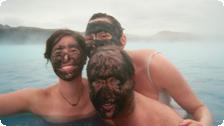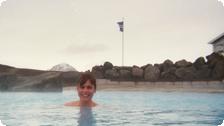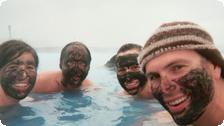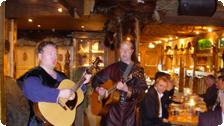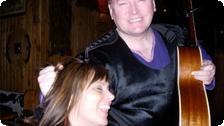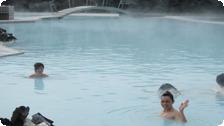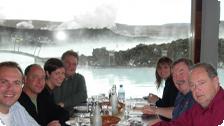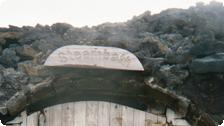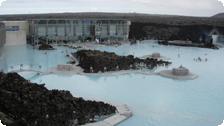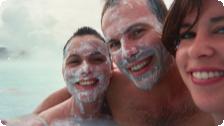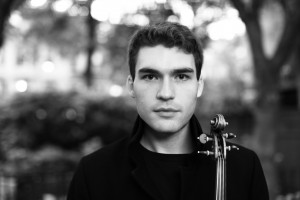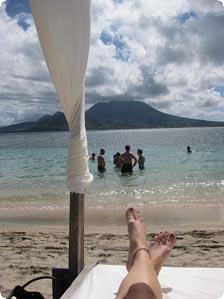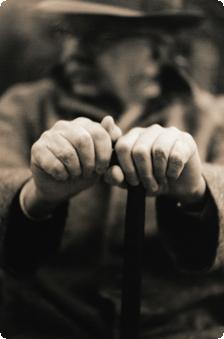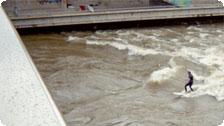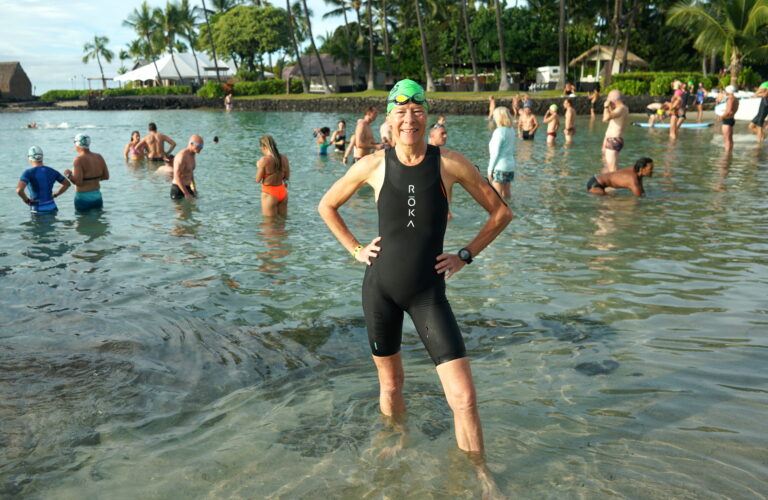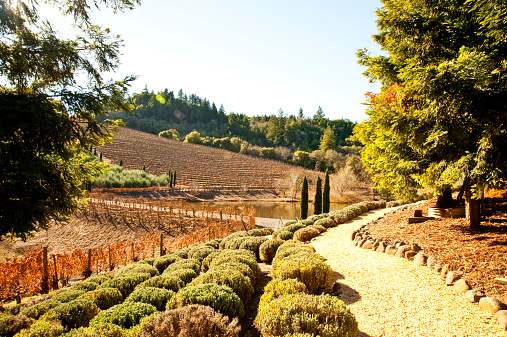Culture: Iceland: Johnny Jet’s Iceland Journal
—Teresa
* * * *
Johnny Jet’s Journal
Greetings from—you may not believe this—Iceland!
I was fortunate to be invited on Icelandair’s inaugural flight from the West Coast (San Francisco) to Reykjavik, and tour Iceland for a week. I admit it: At first I wasn’t sure if I wanted to go. I checked out the ten-day forecast, and the places on our itinerary looked damn chilly: thirty to fifty degrees, with snow showers. However, I have always wanted to see what many people refer to as Europe’s newest, hippest country. Plus, who doesn’t want to take a dip in those geothermal natural baths you always see in travel magazines?
Boarding the Inaugural Flight
On the plane I met five other travel writers: Teresa Rodriguez Williamson from TangoDiva.com; Bob Ecker, a freelance writer for Travel, Wine & Food; Heather Bradley from SOMA magazine; Dennis Cavagnaro from Stars and Stripes Magazine, and Janos Gereben of the Post Newspaper Group. We would all tour Iceland together, so I was relieved they all were very nice. We sat near each other in Icelandair’s Saga class. That’s the name they use for their business class (they have no first class, just coach and business). Saga refers to Icelandic documents written anonymously in the twelfth and thirteenth centuries about the lives of specific people and entire communities.
Icelandair
Icelandair has been flying since 1937, and has long been known as one of the cheapest ways to get to Europe from North America. It has service from New York, Baltimore, Orlando, Minneapolis and now San Francisco—all through Iceland. The new SFO service flies to Reykjavik on Mondays, Wednesdays, Thursdays, and Saturdays through August 31. They will then fly only on Wednesdays and Saturdays until October 15, before stopping for the winter. (For more info on Icelandair’s fares and special stopover packages that include connecting flights to major European capitals, call t 800.223.5500, or click on
www.icelandair.net.)
Landing in Icleand and Video of Flight
Landing in Iceland, I was very surprised at what I saw—or, rather, didn’t see. It looked nothing like Greenland. Iceland was a mix between Kona (Hawaii) and Alaska. It was very barren—no trees, just lava and snow-topped mountains. Now I saw why this place is called the “land of fire and ice.”
Customs and Money
Going through passport control in Iceland is a pleasure. For one, the line wasn’t long. For another, I didn’t have to fill out any custom forms—I just showed my passport. Third, all the agents were fast, friendly, and spoke perfect English. Baggage claim took a while, but I didn’t care. I was just so happy (and impressed) that mine made it! After getting my bag I hit the ATM, like every visitor should. (Tip: Don’t exchange money. The best exchange rates are found traveling international is using credit cards and ATMs). The Icelandic currency is the Króna (abbreviations are ISK, IKR or KR); the current exchange rate is 1.00 USD = 64.57 ISK. Just think that every 1,000 ISK = approximately 15 USD. That rate is not very favorable to Americans, and as you will see, Iceland is really expensive.
Getting Around
Iceland has no railways or highways. The main road here circles the entire island; appropriately, it is called the Ringroad. It was completed only thirty years ago, and for most of its nine hundred miles is a paved two-lane road. It’s considered one of the most desolate and scenic routes in the world. After traveling only part of it, I agree. Sections of the Ringroad are closed in the winter and during bad weather, so be sure to get up-to-date road info at www.Vegag.is. Taxi transportation from the international airport to the city is expensive. A four-passenger taxi costs approximately 8 ISK ($123 USD) for the forty- to fifty-minute ride. Ouch! The best bet is either to rent a car, or take the Flybus which is 1,150 ISK ($17.80) per adult. Children twelve to fifteen pay half price, while those under eleven ride free.
Drive to the Nordica Hotel
We were greeted by Michael, Icelandair’s press guy and he escorted us to our van rental. The forty-five-minute ride to our hotel was like driving on the moon. There is nothing to see. I started to get worried that the whole country would look like that. Thank God it doesn’t. Once we got to the outskirts of the town we started to see grass and trees—phew!
We checked into the four-star Nordica Hotel, the largest in Iceland. It has 284 guest rooms and suites. It’s also one of the two nicest hotels in the country (the other is Hotel Loftleiði, near the domestic airport). The Nordica is very modern and hip, and has a similar chic feel to a W Hotel. The huge lobby offers plenty of places to lounge, including the sociable bar. My room had spectacular views and was clean and bright, with natural wood floors and a comfortable bed. Interestingly, every hotel I stayed in—six different ones over six nights—had twin comforters, even on the full-size beds. The comforters were wrapped in the top sheet, and had one large blanket over it. I guess the twin comforters prevent fighting for covers with your bedmate? Unfortunately, I didn’t get a chance to test out that theory. Room rates range from 15,100 ISK ($234) to 120,000 ISK ($1,800). (Icelandair Nordica Hotel and Spa, Su©£urlandsbraut 2, 108 Reykjavík; t 354.444.5000)
Nordica Spa/Tipping/Girls
The Nordica Hotel is not a good spot if you don’t have a car. The center of town is a solid fifteen-minute walk, and on a cold day that’s far (they do offer complimentary city center shuttle service). But this place is perfect for business travelers, and those who want all the luxuries and comforts of a fine hotel. My favorite part was the spa and workout room. Not only is there new exercise equipment, a juice bar and outdoor sauna, but there are also three different hot tubs, and roving masseuses who give customers free three- to four-minute shoulder massages. They don’t work for tips, either. In fact, no one here tips, not even for dinner or taxis. The Spa is a perfect place for guests to meet locals, since more of them have gym memberships than hotel guest. Icelanders are very cool, friendly and quite beautiful, so don’t be shy starting up conversations. The daily entrance fee to the Noridca Spa is a whopping 2,500 ISK ($38). No wonder the massages are free.
About Iceland
Because Iceland is such a fascinating, exotic place and many people (including me) have little information about the country, I will offer some interesting facts, tidbits and history. Books have been written on each subject alone, so if you want more info just check out the resource section below, or visit your local library.
First, Iceland is in the Western European Time Zone, which puts it seven hours ahead of California and four hours ahead of New York. Iceland is in the north Atlantic Ocean, between Greenland and the Faroe Islands, Scotland and Norway. The entire country is just south of the Arctic Circle (except for the small island of Grimsey). Iceland is filled with arctic desert plateaus, sandy deltas, volcanoes, lava fields, glaciers, and waterfalls. Only 1.3% of the country is grassland, just 1.5% is used for agriculture, and a mere 1.5% is forest (I told you there weren’t many trees). Three percent of the land is lakes, 11% is lava fields, 12% are glaciers, and only 21%—the lowlands near the coast—is considered habitable.
Size and Population
At 39,756 square miles, the country is about the same size as Kentucky or England, but there are a whole lot less people. With a population just under 290,000, there are twice as many sheep and cars. Most residents live near the capital city of Reykjavik (which means “smoky bay” in English, because that’s what it looked like when the Nordic sailors came up and saw all the volcanic steam.) Others are spread out along the coast (the highland interior is uninhabitable).
History and Tidbits
Iceland was settled by Norwegians and Vikings during the late ninth and tenth centuries A.D. Tradition says the first permanent settler, a Norwegian Viking, made his home where Reykjavík is located. Later Iceland became part of Denmark, which it remained until 1918. After independence it kept its ties to the Danish crown until 1944, at which point it became a republic.
I knew many Scandinavian countries follow Norse tradition, using patronymics rather than surnames. But I didn’t know most Icelanders’ given name is followed by his or her father´s name, then the suffix -son or –dóttir. For example, if I lived in Iceland my name would not be Johnny Jet, but rather Johnny Francisson (my dad’s name is Francis). That can be confusing, but thanks to countless medieval documents, many Icelanders trace their ancestors back to the Viking Settlement. Because of this, and Iceland’s location in such an isolated area with limited immigration over hundreds of years, it is regarded as the genetically purest country in the world.
Weather
It’s not surprising that Iceland does not get real hot—but it also doesn’t get ridiculously cold either. January temperatures in Reykjavik are similar to New York City: about 0°C (32 F). In addition, there is not a lot of snow. The mild climate originates with the warm ocean currents from the Gulf of Mexico, and travels via the Gulf Stream. The hottest temperature recorded in the 20th century was 30°C (86F); the coldest was –38°C (-36F). The average summer temperature in Reykjavik is 10.6°C (51F) in July, with average highs of 24.3°C (74F). The big problem with Iceland’s weather is that it always changes. So bring all types of clothes, and dress in layers. When I was there we had unseasonably cold weather (30F-50F), snow showers—and the wind was fierce.
Language
The first language here is Icelandic. It’s very different from Danish, and is not easy to learn or speak. The only thing I can say is takk (thank you), and a phrase that’s only to used late night in a bar (just kidding—even that is difficult to learn). Luckily, everyone here is taught English starting at age ten, and most people speak better English than me. Iceland is tourist-friendly, with many signs and menus written in both Icelandic and English. For those signs that aren’t, here’s a handy a Icelandic-to-English translator. The last notable fact for this week is that the standard of living is high, with per capita income among the best in the world. This is a socialist country, and health care is excellent. In fact, life expectancy is one of the highest in the world: 81.3 years for women, 76.4 for men.
Drive from Reyjavik to Flúðir
We drove from Reykjavik to Flúðir along Route 1 (the Ringroad). It normally takes an hour, but we took our time, stopping to see the topographyand scenic points. The landscape changed drastically as we drove over the mountain, going from areas with no signs of life—only lava—to lush green valleys along the Atlantic Ocean. In the valley we stopped at a store called The Garden of Eden. Hveragerdi is a little community in the middle of nowhere. The Garden of Eden is appropriately named, because there is a large greenhouse with every kind of plant and tree—even banana trees. The building was nice and warm (and humid), and for a second I thought I was in the South Pacific. The Garden of Eden sold everything from hand-knit wool sweaters to an enormous selection of post cards. (The Garden of Eden, Austurmork 25, 810 Hveragerdi, Iceland; t 354.483.4900)
Hotel Flúðir
When we arrived at the three-star hotel Flúðir in a quiet farming town, the wind was blowing and the air was freezing. Their thirty-two-room, one-floor lodge boasts shiny new wood floors and ceiling beams, which makes the hotel feel nice and cozy. The small but clean rooms come with a comfortable bed, TV and telephone. The restaurant offers not only fantastic views of the countryside, but a top-rated chef, formerly of Reykjavik. He served us a fine breakfast and lunch. Room rates range from 10,200 ISK ($155 USD) to 16,200 ISK ($250 USD). (Hotel Flúði, Vesturbrún 1 845 Fludir; t 354.486.6630)
Golden Triangle Tour with Iceland Rovers
After lunch Kristjan and Arnar, who work for the tour company Iceland Rovers, picked up in two Super Jeeps. Each fits seven passengers comfortably, and is capable of all kinds of off-road adventures. When they told us we would tour for nine hours, I thought that was way too long. But the time flew by, because there was so much to see and because Kristjan and Arnar were so cool and interesting. They not only knew the area really well, but the history too. Iceland Rovers offers many types of tours. They range from five to twelve hours, and cost from 15,500 ISK ($235USD) to 21,900 ($330). (Iceland Rovers, t 354.567.1720)
Gulfoss (“Golden Waterfalls”) Geysir
Our first stop on the Golden Triangle Tour was one of Iceland’s most famous waterfalls, Gullfoss. From a faraway lookout point Gullfoss is something, but those willing to walk down a path, battling the cold wind and spray to reach the 500-foot-high ridge are rewarded by feeling the impressive power behind these thundering falls. When our fingers went numb we jumped back in the Jeep, and drove twenty minutes to the Great Geysir. Believe it or not, this Geysir is the namesake of all geysers. Geysir is a Danish word, meaning “gusher” or “spouter.” Great Geysir used to shoot eighty yards in the air, but tourists or locals throwing rocks in its hole, so now the great geyser is dormant. However, a few yards away the geyser Strokkur goes off every seven minutes or so, awing visitors. A few hundred feet away is the Geysir café/souvenir shop, where tourists get warm while trying one of Iceland’s many candy or ice cream bars. (Sirius is the local chocolate.)
The Old Parliament
After Geysir we took a long, desolate road for thirty minutes. We passed just a few cars, until we reached the River Oxara in Thingvellir. That’s where Althing (the Icelandic Parliament) gathered for the first time in A.D. 930. That makes Iceland’s parliament the oldest in the world. Legislators met there every late June or early July for two weeks, until 1798.
Nearby is a monster rock wall called Almannagja, a fissure of the Mid-Atlantic ridge. (This is one of the places I mentioned on my website last week, where the earth is pulling apart.) A few feet from the wall, we were fortunate to witness a pagan wedding. Our native Icelandic guides said they had never seen one before. That’s how rare it is—not to mention illegal.
Dinner in Stokkseyri and Hakarl
Dinner was in Stokkseyri, a quaint fishing village on Iceland’s South Beach. Before walking into the restaurant, Kristjan broke out a jar filled with bite-size pieces of hakarl (decomposed mouldy shark). This is one of Iceland’s most famous delicacy, and goes back centuries. Back then, food options were limited. Icelanders had no means of preserving food except salting, smoking, soaking in mysa (whey), or going with nature and allowing it to rot for six months—long enough for the decomposition process to end. How nasty is that?
When they took the lid off the jar it had the foulest smell ever. I almost yacked just taking a whiff. Not surprisingly, most of our group did not like this treat (though one person had seconds). To wash it down our hosts brought out another local tradition: Icelandic Schnapps. It’s called brennivin, which translates to Black Death. That refers to the mid– fourteenth century black plague, which killed between half and two-thirds of Iceland’s population. Maybe it’s named for the Black Plague because it’s thirty-five percent alcohol.
Fjorubordid Restaurant
I didn’t like the hakarl, but I did love the seafood restaurant that served steamed lobster tails (crawfish) by the bucket, with potatoes. I’m not usually a seafood fan, but they looked and smelled so good—smothered in garlic and butter—that I had to at least taste them. They were so great (and didn’t leave a fishy taste) that I had seconds. I even finished my bowl of lobster bisque, and of course I polished off the incredibly rich snicker pie. Diners come here from Reykjavik; it’s well worth the easy forty-five-minute drive. (Fjorubordid, t 354.483.1550)
Saga Museum
The next day we drove back to Reykjavik (in snow showers). We visited Perlan (The Pearl), a funky glass domed building that sits atop a hill overlooking Reykjavik and the domestic airport. Inside we took a tour of the Saga Museum by curator Ernst Backmann. (Most people get a guided tour on CD, included in the entrance fee). This place intimately recreates key moments in Icelandic history, and with its lifelike replicas blows Madame Tussaud’s away (some even move ever so slightly). Everything from the weapons and clothing to everyday objects was constructed using traditional methods, passed down through the ages. The molds, made by Ernst himself, are modeled on his relatives and friends. The mood is set by soft, spooky background music and dim lights. It would be a perfect place for a Halloween party, or to learn about the Vikings (or “Wikings, Icelanders pronounce it). (Saga Museum, t 354.511.1517)
The Pearl Restaurant
Upstairs at the Perlan, a revolving restaurant is open only for dinner, or in the afternoon for special occasions. Stefan Sigurdsson, the master chef and general manager, made us prosciutto, salmon, and lamb. Everyone enjoyed the meal, as we slowly turned to see the spectacular views of Reykjavik. (The Pearl, t 354.562.0200)
Flight to Akureyri
I almost didn’t go on this trip because I found out we would fly in a small plane to Akureyri, in northern Iceland. I was worried about the trip until I met Yvonne at check-in. Just kidding—my fear went away when I saw the planes were not small after all. They were fifty-seat Air Iceland Fokker 50s. We departed from Reykjavik airport (airport code RKV), the domestic airport very close to the Pearl restaurant. Although it was quite windy, which always freaks me out, the forty-five-minute ride was smooth and enjoyable. (Air Iceland, t 354.570.3030)
Akureyri
Though Akureyri is the capitol of the north, it is a town of only 15,000. Still, that makes it Iceland’s second largest city. It sits on the Eyjafjordur fjord, the longest in Iceland (we saw a huge iceberg that floated over from Greenland in it). Akureyri was ten degrees cooler then Reykjavik. The average temperature in July is 11.2ºC (52 F); in January it’s -1.3ºC (29F). We saw a lot of snow flurries, which everyone said was unusual; it was unseasonably cold. People come to north Iceland because it is arguably the most beautiful part of the entire country (I think so too). It’s also the jumping-off point for the Arctic Circle (the island of Grimsey is 24 miles away). This is also the best place to see the winter Northern Lights (Aurora Borealis).
Fridrik V
For dinner we drove twenty minutes into downtown Akureyri. Fridric V brasserie, one of Akureyri’s best restaurants, specializes in fresh Icelandic fish, greens and meat, cooked modern European style. The food was really good, and the service was excellent. I continued to expand my palate when we were first served goose soup in an espresso cup. I drank it only because the chef was so enthusiastic (and standing right behind me). But I’m glad I did, because it was delicious. I only wish he hadn’t told me what it was. Our main entrée was seafood and a tasty chicken dish. For dessert we had panna cotta, brown cheese and more Black Death. After shots of that we hit the town, until the wee hours. (Fridrick V, Strandgata 7, IS-600 Akureyri, t 354.461.5775)
Drive to Husavik and Laufas
From Akureyri we drove to Husavik. The drive should take an hour, but we stopped at several places. The first was a traditional Icelandic farmhouse called Laufas. The historic settlement looked picturesque, with its Christian church (built in 1865) surrounded by a colonial American-looking graveyard. From the road the old farmhouse looked like four tiny turf buildings, but in actuality it is one gigantic place that housed twenty to thirty people. It’s now a museum containing household items and utensils used at the start of the twentieth century. Open May 15 to September 15. (The old farmhouse Laufas, t 354.463.3196)
More Waterfalls
There are thousands of waterfalls in Iceland, yet it’s hard to get sick of them because they are so beautiful. We stopped briefly at Goðafoss (Waterfall of the Gods) in Eyjafjodur. In A.D. 1000 Ljósvetningagoði (Lord of Ljósavatn), after given the authority by the other members of parliament to decide which religion would be adopted by the Icelanders, chose Christianity, and dumped the pagan gods he formerly worshipped into this waterfall.
Husavik
Husavik is a small fishing village of 2,500 people. It was the first place in Iceland ever built (in 870, by Swedish Viking explorer Gardar Svavarsson). The quaint town offers a spectacular view over the bay of Skjáifandi, which leads to the Arctic Ocean. We had lunch in a charmingseafood restaurant, and I was so happy to find out they were making me a cheeseburger. That was, until I bit into it and realized the gamy taste could only be from a lamb. Iceland, of course, is a seafood lover’s dream—the seafood is among the freshest in the world, and fishing is Iceland’s leading business. Seafood exports account for approximately half of all foreign exchange earnings. Still, less than ten percent of the workforce is involved in fishing. (Tourism is the second-largest industry). (Gamli Baukur, Höfnina, Húsavík, t 354.464.2442)
Husavik Whale Museum
Most people come to Husavik to go whale watching. That’s why we were there, but the weather was so bad we had to forgo our three-hour excursion. Instead we spent more time in town, and at the Husavik Whale Musuem. Asbjorn Bjorgvinsson (Abbi), the creator and manager, started out as an electrician. But when a friend asked him to go on a boat to help translate for the English passengers, he fell in love with whales. Since then he has devoted his life to whales. He has become one of Iceland’s most outspoken residents in favor of banning whaling (a touchy subject in Iceland, about which the locals are split). The two-story museum has everything you want to know about whales and whaling. For example, rubbing whale skin feels like an olive. The museum even has a section dedicated to Keiko, the captive orca who starred in the hit movie Free Willy. (Trivia: Kieko was brought back to his native Iceland before he died in 2003.) (Husavik Whale Museum, Hafnarstettinni; t 354.464.2520)
Penis Museum
A few feet away is the controversial and surprisingly popular Icelandic Phallological Museum. It houses ninety-nine specimens of…penises. They range in size from the biggest—the aptly named sperm whale—to the smallest, a hamster. (That one requires a magnifying glass to see, poor fellow.) The museum has been written up in many publications, including Time magazine. After visiting this place, I can pretty much say I have seen it all. Entrance fee is 500 ISK ($7.70). (The Icelandic Phallological Museum, Hedinsbraut 3a, 640 Husavik; t 354.566.8668)
Puffins
Puffins are black and white seabirds that grow to about ten inches tall and have colorful orange beaks. There are four different species in the world; Iceland is home to the Atlantic one. We pulled up to a spot, and our guide said we had a short walk to find some puffins (it was early in the year for them, so we had to search). A while later I realized Icelanders are much tougher than Americans, because that short walk was actually a long hike. In addition, the air was freezing, the wind was blowing and the snow was blinding. Icelanders are probably so tough because beginning at six months, they are placed outside (wrapped in blankets) in the winter for an hour of fresh air.
Dinner in Husavik
We had dinner at Salka restaurant in the center of Husavik. They have a diverse a la carte selection and a full pizza menu (yeah, baby—finally, some comfort food that didn’t taste like fish or lamb). I knew they were making us a special seafood meal, so I quietly asked our waitress if I could get a pizza instead. She recommended the Hawaiian; I said aloha! It wasn’t all that good compared to New York standards, but at the time it was delicious! You should’ve seen the look on my colleagues (who had been eating seafood every meal) faces when my pizza came out. I could have sold them a slice for $20—but instead I was smart enough to order a large, so we shared. (Salka, Gardarsbraut 6, 640 Husavik, Iceland; t 354.464.2551)
Hotel Reynihlid
We drove forty-five minutes to M?vatn (population four hundred) where we checked into the Hotel Reynihlid. This 41-room hotel in the heart of the Lake Myvatn area (which is really out in the middle of nowhere) offers excellent accommodations. It’s rated 4 stars (in the Icelandic Tourist Board classification). The hotel offers a helpful staff, lively restaurant and bar, along with high-speed internet and clean, comfortable rooms with a desk, TV, bathroom and good views. Rates range from 9,867 ISK ($151) to 20,845 ISK ($320). Hótel Reynihlíd, Reynihlid, Lake M?vatn, Iceland; t 354.464.4170)
Myvatn
Lake Myvatn is Iceland’s fourth largest lake (twenty-two square miles). It lies inland, in the northeastern part of the country—one of the most volcanically and geothermally active parts of Iceland. The smell of sulfur is heavy in both the air and the tap water. (Icelandic water is good for your skin, making it nice and smooth). The shallow lake includes fifty small islands. The name means Midge Lake, in honor of all the pesky gnats, but fortunately it was too cold for us to experience them. We did see plenty of birds, which was not surprising. This place is world-famous for its 2,000 types of birds. The fifteen species of ducks are the most in all of Europe.
Namafjall
Driving to mount Námafjall looked like a scene out of Mad Max. The stacks of smoke in the distance, combined that with the utter desolation of the area, made it feel like the world had been nuked. It was so eerie. The stacks of smoke were actually steam coming from Hverfell, a huge crater where the colors are vividly light, and the mud flats are so hot they bubble.
Krafla
We were in the same area that the Apollo 11 crew practiced moonwalking in the late 1960s. The astronauts later said this place looked more like the moon than the moon itself! Then we hopped back in the van and drove a short distance off the main road to Krafla Landsvirkjun, the world’s first geothermal electrical power plant. Visitors can get a free first-hand look at Iceland’s natural power. (Landsvirkjun, Haaleitisbraut 68 201 Reykjavik, t 515.9000)
Bread from the Ground
One of the neatest things we witnessed was seeing café owner Ólöf bake her hverabraud (sweet rye bread) using nothing but geothermal heat from the lava fields. She had put her loaf in the earth oven for nineteen hours, then pulled it out, brought it to her café and served it to us warm with sweet butter and jam. It was delicious, as were Ólöf’s homemade mozzarella and feta cheeses, and skyr (Iceland’s version of yogurt). Ólöf’s café is on her farm, and through the windows in her café visitors can watch cows being milked (twice a day, at 7 a.m. and 5:30 p.m.). Customers can even milk a cow if they like, and taste the super-fresh milk. Milking a cow is quite disturbing for a man. I struggled as I tried to pull on one of the cow’s udders to get milk. Ólöf came over to help, and after I pulled in the direction she showed me, she said, See, it’s coming. I immediately let go and said I’ve had enough. We then checked out her sheep, which was more comfortable for me. Here’s a video of Ólöf making bread, and our visit to her café/farm. (Vogafjós Café, 425 Vogafjós, 660 M?vatn; t 354.464.4303)
Trolls
I read that over 50% of the Icelanders either believe in or do not deny in the existence of trolls and hidden people (huldufolk). I’m an open-minded person, but I didn’t really buying into it until we visited Dimmuborgir (“Dark Citadels”). Our guide, Thoran, told us that the area we were walking around in is believed to have once been a troll party. He knew this because the trolls forgot about the time, and when the sun came up they all turned into stone. Looking at these strange rock formations that definitely appeared to be petrified trolls rising above lava plains, and hearing the stories, gave me goose bumps. Maybe it’s true…
Natural Geothermal Baths
We visited the coolest thing on earth: natural geothermal baths, which people of the M?vatn region have enjoyed ever since Iceland was settled by the Vikings. The healthy water contains a unique blend of minerals, silicates and geothermal microorganisms (including sulfur, so be sure to remove your silver jewelry so it doesn’t get tarnished). Sulfur itself, however, is considered beneficial for patients with asthma and other respiratory diseases; many trace elements in the water are helpful for skin conditions.
Myvatn Nature Baths
The M?vatn Nature Baths are an oasis. They opened in June of 2004, and are even nicer than what I imagined. The tastefully designed complex offers bathers a completely natural experience. The temperature outside was 31 degrees, and it was snowing. After my mandatory shower I donned my wool hat in case my head got cold (I didn’t need it). I walked as fast as I could to the edge of the sliver blue water, where clouds of steam rose from a fissure deep in the Earth’s surface. I slowly waded to the middle of the bath and tried to relax. But I couldn’t; I was too excited. To think it was snowing, I was surrounded by snow-capped mountains and chilling (I mean boiling) in 36–40°C [96-104°F] soothing water in Iceland. That was something I’ll never forget. We didn’t even shower afterward, because the minerals are so good for the body. (TIP: To beat the crowds, show up either very early or real late). Price: adults 1,100 ISK ($17.25), children 8–16 550 ISK ($8.60), handicapped people, patients with psoriasis and other skin diseases, and senior citizens 67 and older: 880 ISK ($13.80). Hours: summer 9 a.m. to midnight; winter: Mondays–Fridays 4 p.m. to 10 p.m.; Saturdays and Sundays, noon to 10 p.m. (Myvatn Nature Baths, Jardbadsholar, Myvatn; t 354.464.4411)
Hotel Kea in Akureyri
After our amazing bath we drove seventy-five minutes back to Akureyri. There we visitied the world’s most northerly eighteen-hole golf course, the site of the annual Artic Open. (Fun fact: There are sixty-two golf courses in Iceland). Then we walked around the really cute small town. We had dinner at an okay but expensive ($25 for a bowl of pasta) Italian restaurant near our hotel. We spent the night in the four-star Hotel Kea. Located in the heart of Akureyri, it is not only elegant but very comfortable. I had a nice room with a view of the fjord, and caught up on some work using free wireless high-speed in the bar area. Summer rates start at 14,640 ISK ($220). (Hotel Kea Akureyri, Hafnarstræti 87-89, 600 Akureyri; t 354.464.4455)
Back to Reyjavik
The next morning we flew forty-five minutes back to Reykjavik. We headed straight downtown, where we picked up tourist cards giving us free admission to a good selection of museums, galleries and all swimming pools in Reykjavik. Swimming is huge here! The cards are available for one (1.200ISK = $18), two (1.700 ISK = $26) or three days (2.200 ISK = $34). I walked around town, checking out the modern museum, outdoor cafes, shops, and grocery stores. The exchange rate makes things ridiculously expensive; for example, a pint of Ben & Jerry’s ice cream cost $13.30. The good news is, with prices like these I would be a skinny man. However, I did have to sample Iceland’s homemade ice cream, which you see everyone eating on what they consider to be a warm day.
Seafood Cellar
We had lunch downtown at the Sjávarkjallarinn Seafood Cellar. I wasn’t looking forward to this lunch for obvious reasons (if you’re a regular reader you know I don’t eat seafood), but I was pleasantly surprised. This Asian-Icelandic fusion restaurant was delicious. The bread could have been a meal in itself. It was amazing, especially after dipping into the olive oil and the couscous. We were served sushi, soup, chicken, fish, and noodles. It was all good! (Sjávarkjallarinn Seafood Cellar, t 354.511.1212)
Ice Bar
After lunch we walked across the street to Kaffi Reykjavik. We were encouraged to put on a jacket, because we were about to step into an ice bar that is kept year-round at -5°C (23F). Nearly everything in there—even the glasses—is made of clear ice from glaciers. The only thing not made of ice were the bottles of booze. This bar is cool (pun intended), but unfortunately is frequented only by tourists. (Kaffi Reykjavik, Vesturgata 2, IS-101 Reykjavik, Iceland; t 354.552.3030)
Holdi House
After our group had shots of black death (Icelandic Schnapps called brennivin) we took a mini-tour of the city with Reykjavik Excursions. The most interesting place we saw was the Hofdi House, where President Reagan and Soviet General Secretary Gorbachev met during the Reykjavik Summit in October 1986.
Religion and Hallgrim’s Church
The tour ended with a stop at the country’s most famous and largest (seating capacity: 1200) church. Hallgrimskirkja is Lutheran (the religion of 95% of the Icelandic population). Hallgrimskirkja was built from 1945 to 1986. The length of construction is one reason it became controversial; the other is its unique design. We were told the steeple is reminiscent of the rugged mountains and icecaps. The church is open to the public, and visitors should take the elevator up the 232-foot steeple (350 ISK = $5.40). Make sure to go all the way to the top, by taking a few flights of stairs for a real bird’s-eye view underneath the twenty-nine chime bells. The views of Reykjavik from there are incredible. But bring a hat—it’s so windy that the four huge clocks on each side of the steeple rarely tell the correct time. All four usually show different times, because the winds always change directions. I happened to be up there at the top of the hour, which I didn’t realize is when the bells go off. I literally had my bell rung! It was so loud, it almost scared the religion out of me. (Hallgrímskirkja, Skólavör©£uholti, Pósthólf 651, 121 Reykjavík; t 354.510.1000)
The Viking’s Hotel
Our last night in Iceland was spent fifteen minutes from Reykjavik, on the way to the airport at the fishing town of Hafnafjordur. We stayed at the Viking Hotel. It’s a fun place that kids love. The staff is super-friendly— and they all wear Viking costumes. All 29 rooms have Viking décor, just like the rest of the property. I stayed in room 1, which the owner said was the worst in the hotel. It was small and lacked a good view, but it worked for me because I was there for only one night, plus I was able to log on to free wireless internet. Room rates (breakfast included ): October to March, 5.800 ISK ($90) to 8.100 ISK ($125); April to September 10, 800ISK ($166) to 14.000 ISK ($215). (The Viking Village, Strandgata 55, 220 Hafnarfjordur; t 354.565.1213)
Viking Dinner
Next door to the hotel is the Viking Restaurant, which serves a traditional Viking feast, on old-fashioned Viking trays. People come here from the city (they offer free transportation to and from Reykjavik) just for the traditional meal that is accompanied by singing Vikings and Valkyries. For starters we had shark and dried haddock the Viking way (that means chilled brennivin schnapps is used as the chaser. The main entrée was braised lamb shank with potato pureé and glazed vegetables (I had chicken). Dessert was skyr with blueberry sorbet. When there are no children around, the Vikings are really funny and politically incorrect. Price for dinner and drinks: 5.600 ISK ($86). (t 354.565.1213)
Blue Lagoon
The Blue Lagoon opened in 1999. It is now Iceland’s number one tourist attraction, and the spot where we ended our trip. It is halfway between the Viking Hotel and the airport, twenty minutes from each. Because it’s so close to the airport, lucky passengers on certain flights (currently just London passengers on Icelandair) with a long enough layover can come for a relaxing dip in the Geothermal Spa. Temperatures range from 37 to 39°C (98 to102°F). This place is different from the one we visited in Myvatn. The big difference is that Blue Lagoon is much larger and more commercial. Another difference is that here they use seawater. This water is also known for its positive effects on the skin, but bathers here should shower afterwards.
I was amazed at the technology used for the entrance and lockers. Visitors are given a yellow wristband that with a small white chip that’s made in Slovenia. This allows you to enter and exit, and open and lock your locker. It’s easy to use, and the system is state-of-the-art.
After a quick shower, I joined the others in the Blue Lagoon. This was another incredible experience, and I don’t know which one I liked best. They are so different. I did love the Blue Lagoon’s waterfall, which provides an energizing massage. Visitors are also offered real massages, and body and face treatments while floating in a private area of the pool. A very hot steam bath in a dark lava cave is a must visit; you should also try the sauna with a cold-water sprinkle. I hung out with my colleagues and the women from the Dutch national handball team, who were playing in Iceland.
Blue Lagoon has wood buckets in designated areas filled with soft white silica mud. Bathers apply it to their face to cleanse, exfoliate and revitalize the skin, leaving it silky smooth. Lifeguards dressed in winter jackets come around with trays of the Blue Lagoon blue cocktail, a concoction of Champagne, 7-Up and blue Curacao. After showering, visitors are encouraged to put lotion all over their dry body. I did that, then had lunch in the Blue Lagoon restaurant. The food was good, but the dip was outstanding. Blue Lagoon Geothermal Spa is open daily year-round. September 1 to May 14, 10 a.m. to 10 p.m.; May 15 to August 31, 9 a.m. to 11 p.m.. Prices: adults 1.300 ISK ($20), senior citizens (67 years and older), 900 ISK ($14), youngsters 12 to 15 600 ISK ($9); children 11 and younger are free. You can rent bathing suits (350 ISK = $5.30) and towels (300 ISK = $4.60) your can rent them. (Blue Lagoon, 240 Grindavík, Iceland; t 354.420.8800)
Next week we are back in America—but not home in California.
Happy Travels,
Johnny Jet
Discover more from Tango Diva
Subscribe to get the latest posts sent to your email.
